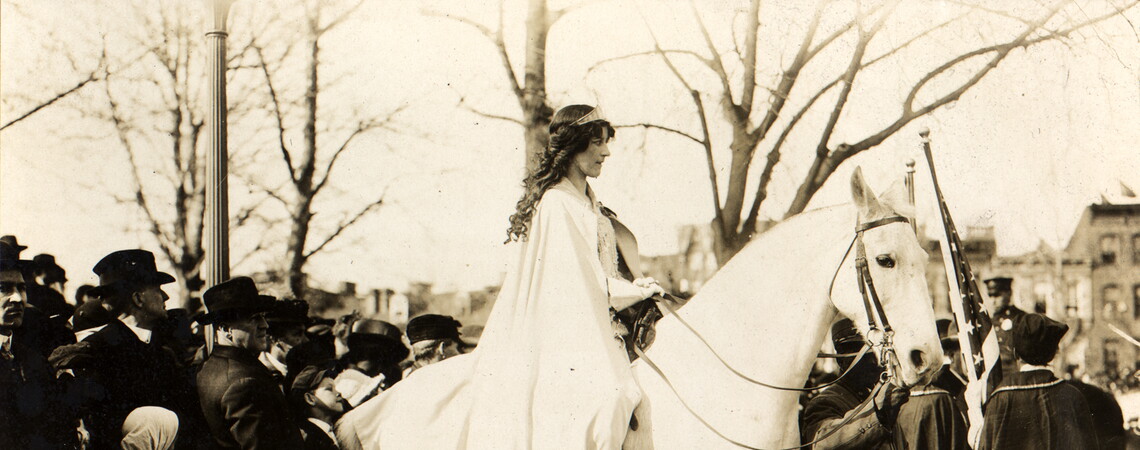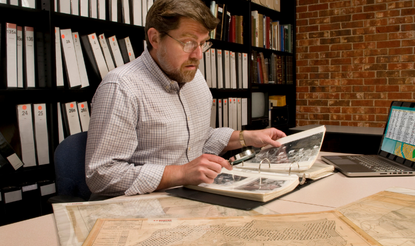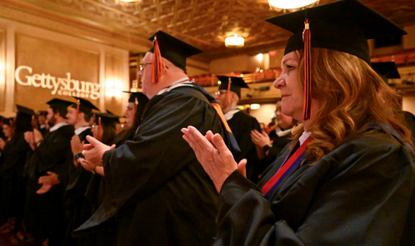Reconstruction and the Battle for Woman Suffrage
by Ellen DuBois
The origins of the American women’s suffrage movement are commonly dated from the public protest meeting held in Seneca Falls, New York, in July 1848. At that historic meeting, the right of women to join with men in the privileges and obligations of active, voting citizenship was the one demand that raised eyebrows among the hundred or so women and men attending. As Elizabeth Cady Stanton, the meeting’s prime organizer, remembered it, many in the audience, even including the distinguished radical Lucretia Mott, worried that the demand for political equality was either too advanced or too morally questionable to include on the launching platform of the new movement. Joined only by abolitionist and ex-slave Frederick Douglass, Stanton argued for the importance of women’s equal participation in the electoral process. In the end, the suffrage resolution passed, the only one of the meeting’s thirteen demands not to be unanimously embraced. From that point it was another three-quarters of a century to the 1920 ratification of the nineteenth constitutional amendment, which prohibited the states from "disfranchisement on the basis of sex."
Given the seventy-two years between the one event and the other, a full third of our history as a nation, the story of the demand for equal suffrage involves many stops and starts, and numerous shifts and splits. Moreover, the exact terms and times of the triumphant end were not—and could not have been—envisioned by those present at the beginning. Differences in and conflicts over leadership, shifting political environments, and various strategies and tactics all mark the long and complex history of the women’s suffrage movement, which lasted far longer than its instigators imagined and yet was shorter than it could have been (when we consider, for instance, the additional three-and-a-half decades that elapsed before women won the right to vote in that other eighteenth-century revolutionary nation, France).
This essay will consider the impact of the Civil War and Reconstruction epoch on the American battle for women’s suffrage. As of 1860, the right to vote was not the primary demand of the women’s rights movement, which focused much more on the economic rights of women—and especially of wives—to earn, inherit, and hold property. In addition, because the common reading of the federal Constitution was that it was up to the separate states to determine how to establish the electorate, women’s rights activists assumed that women’s suffrage—along with women’s economic and other rights—had to be fought for and won state by state. Thus, it was not anticipated that winning the right to vote would involve an epic battle over the federal Constitution. We should remember that as of 1860, only twelve amendments—ten of them consisting of the Bill of Rights dating from 1789, and the other two of largely procedural significance—had been ratified. What we know now—that the history of American federal constitutionalism would be marked by alternating periods of interpretation and amendment, of fierce battles waged far beyond Congress and the Supreme Court to alter and augment the shape and meaning of our foundational political document—was not obvious then; nor was it obvious that women’s suffrage would be the most prolonged of all these constitutional wars.
The very first of those periods of constitutional struggle occurred during the era of postwar Reconstruction, which is when the women’s suffrage movement took on many of the characteristics that it was to maintain for the next half century. Emerging out of the Civil War, the issue of political equality for women was inextricably bound up with the unsettled political status of the former slaves. When the Thirteenth Amendment passed Congress (with the help of a massive petition campaign engineered by the women’s rights movement) and was ratified by the states, the former slaves were freed, but the absence of chattel slavery did not specify what the presence of freedom meant legally and constitutionally. To resolve the anomalous position of the freed population, the Fourteenth Amendment declared that "all persons born or naturalized in the United States were citizens thereof," with all the "privileges and immunities" of national citizenship. Without specifying exactly what these privileges and immunities were, the second section of the amendment went on to address the crucial question of voting rights for the freedmen, a question of particular concern to the ruling Republican Party, which looked to them as a loyal constituency in the states of the former Confederacy.
The Fourteenth Amendment addressed the question of enfranchisement in an indirect, elaborate, and ultimately ineffective way: by pinning a state’s number of seats in the House of Representatives to the proportion of the adult population that was permitted to vote. There were, however, two qualifications to this population basis for determining representation: "Indians not taxed" were excluded, and the amendment specifically defined the potential electorate as "male." Here, for the first time, was an explicit reference to gender in the US Constitution. Since the women’s rights movement was now in its second decade and included a call for political equality in its platform, the amenders of the Constitution could no longer assume, as had the Founders, that "we the people" simply meant men, and did not include, in any politically significant way, women. Women had to be explicitly excluded or they would be implicitly included.
Women’s rights activists objected strongly to what Elizabeth Cady Stanton angrily called "that word ‘male.’" They sent petitions to Congress while the amendment was still being drafted, begging for a change in language, but the amendment passed Congress and was sent to the states for ratification with the disturbing qualification of gender intact within it. Women’s rights activists objected and criticized, but were caught between their recognition of the importance of political rights for the freedmen and their dedication to their own cause of women’s rights. So they stopped short of calling for non-ratification of the Fourteenth Amendment.
Later, because the measures used in the Fourteenth Amendment to encourage black enfranchisement were too weak, a third postwar amendment was designed, this time to address the issue of suffrage directly. The Fifteenth Amendment, passed by Congress in 1869 and ratified a year later, explicitly forbade the states to deny the right to vote to anyone on the basis of "race, color or previous condition of servitude" and authorized Congress to pass any necessary enforcement legislation. The wording, it should be noted, did not transfer the right to determine the electorate to the federal government, but only specified particular kinds of state disfranchisements—and "sex" was not one of them—as unconstitutional.
At this point, the delicate balance between the political agendas of the causes of black freedom and women’s rights became undone. The two movements came into open antagonism, and the women’s rights movement itself split over the next steps to take to secure women the right to vote. Defenders of women’s rights found themselves in an extremely difficult political quandary. Would they have to oppose an advance in the rights of the ex-slaves in order to argue for those of free women? At a May 1869 meeting of the American Equal Rights Association, a group that had been organized three years earlier by women’s rights advocates to link black and woman suffrage, Elizabeth Cady Stanton gave vent to her frustration, her sense of betrayal by longstanding male allies, and her underlying sense that "educated" women like herself were more worthy of enfranchisement than men just emerged from slavery. She and Frederick Douglass had a painful and famous public exchange about the relative importance of black and woman suffrage, in which Douglass invoked images of ex-slaves "hung from lampposts" in the South by white supremacist vigilantes, and Stanton retaliated by asking whether he thought that the black race was made up only and entirely of men. By the end of the meeting, Stanton and Susan B. Anthony had led a walkout of a portion of the women at the meeting to form a new organization to focus on women’s suffrage, which they named the National Woman Suffrage Association.
A second group, under the leadership of Massachusetts women Lucy Stone and Julia Ward Howe, formed a rival organization, known as the American Woman Suffrage Association. This wing counted on longstanding connections with abolitionism and the leadership of the Republican Party to get women’s suffrage enacted once black male suffrage had been fully inscribed in the Constitution. Over the next few years, both the American and the National Woman Suffrage Associations spread their influence to the Midwest and the Pacific Coast. The National Woman Suffrage Association linked political rights to other causes, including inflammatory ones like free love, while the American Woman Suffrage Association kept the issue clear of "side issues." For the next few years, the two organizations pursued different strategies to secure for votes for women. Starting with an 1874 campaign in Michigan, the American Woman Suffrage Association pressed for changes in state constitutions. Because these campaigns involved winning over a majority of (male) voters, they were extremely difficult to carry out, and it was not until 1893 that Colorado became the first state to enfranchise women.
Meanwhile, the National Woman Suffrage Association refused to give up on the national Constitution. Doubtful that any additional federal amendments would be passed, the group sought a way to base women’s suffrage in the Constitution’s existing provisions. Its "New Departure" campaign contended that the Fourteenth Amendment’s assertion that all native-born or naturalized "persons" were national citizens surely included the right of suffrage among its "privileges and immunities," and that, as persons, women were thus enfranchised. In 1871, the notorious female radical Victoria Woodhull made this argument before the House Judiciary Committee. The next year, hundreds of suffragists around the country went to the polls on election day, repeating the arguments of the New Departure, and pressing to get their votes accepted.
Among those who succeeded—at least temporarily—was Susan B. Anthony, who cast her ballot for Ulysses S. Grant. Three weeks after the election, Anthony was arrested on federal charges of "illegal voting" and in 1873 was found guilty by an all-male jury. Anthony was prevented by the judge from appealing her case but another "voting woman," Virginia Minor, succeeded in making the New Departure argument before the US Supreme Court in 1874. In a landmark voting and women’s-rights decision, the Court ruled that although women were indeed persons, and hence citizens, the case failed because suffrage was not included in the rights guaranteed by that status. The 1875 Minor v. Happersett ruling coincided with other decisions that allowed states to infringe on the voting rights of the southern freedmen, culminating over the next two decades in their near-total disfranchisement.
Although these various Reconstruction-era efforts failed to enfranchise women, they did leave various marks on the continuing campaign for women’s suffrage: a shifting focus on state and federal constitutional action, a legacy of direct action, a women’s suffrage movement that was largely cut off from the efforts of African Americans for their rights, and, perhaps most fundamentally, an independent movement of women for women, which turned the campaign for suffrage into a continuing source of activism and political sophistication for coming generations of women.
Ellen DuBois is a professor of history at the University of California, Los Angeles, and the co-editor, with Richard Candida Smith, of Elizabeth Cady Stanton: Feminist as Intellectual (2007); co-author, with Lynn Dumenil, of Through Women’s Eyes: An American History with Documents (2005); and author of Harriet Stanton Blatch and the Winning of Woman Suffrage (1997).



